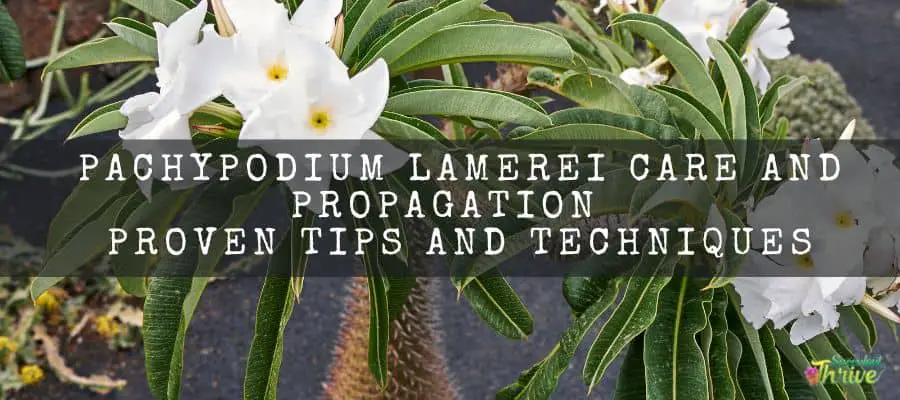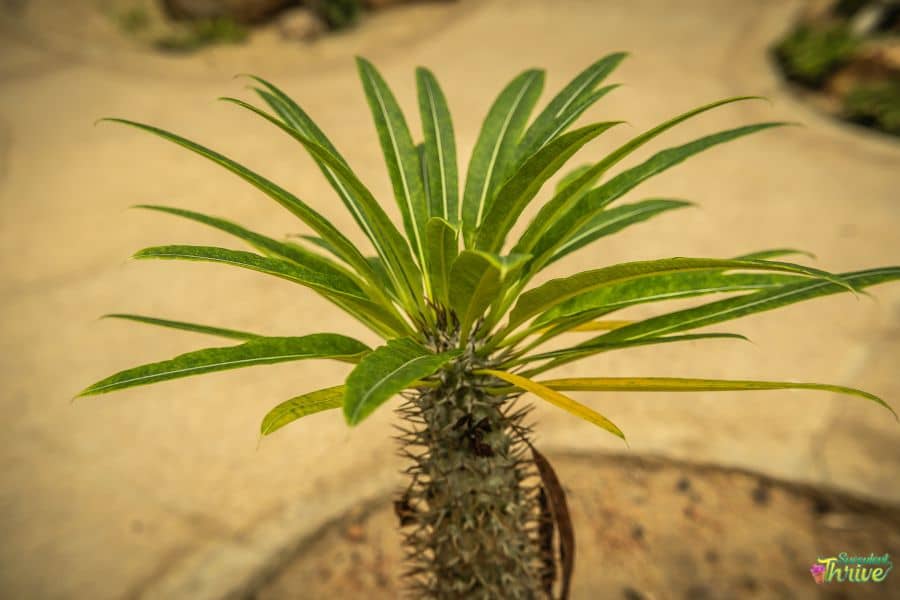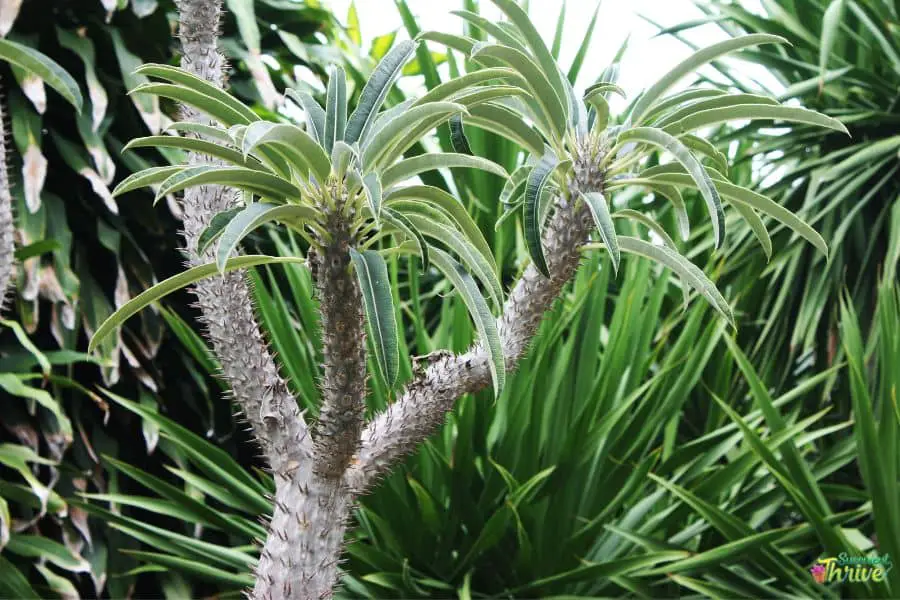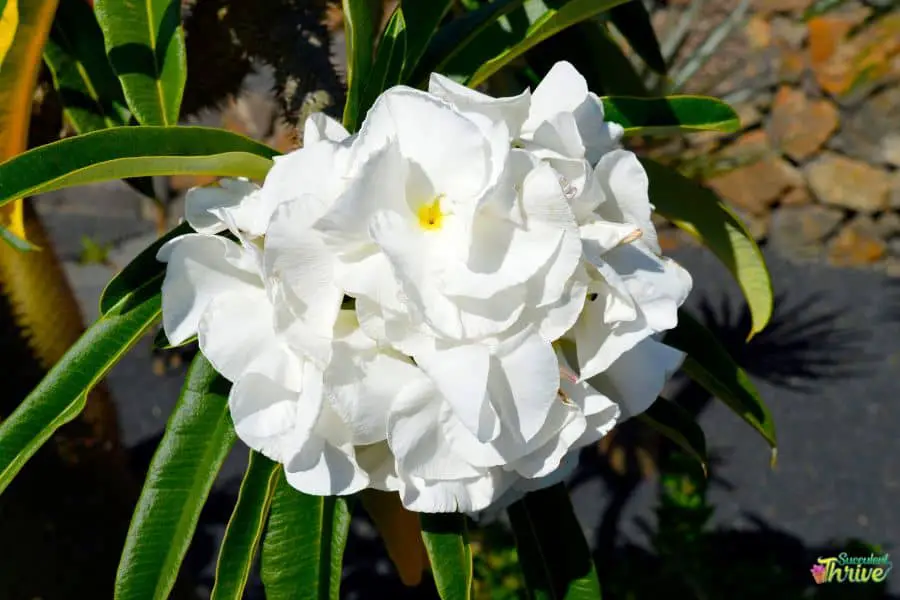Pachypodium lamerei, commonly known as the Madagascar Palm or Spiny Pachy cactus, is an interesting and beautiful succulent that has captivated many a gardener. It’s easy to see why – with its distinctive trunk-like shape and vibrant flowers, it adds exotic beauty to any garden! In this article, I’m going to explore all the wonders of this unusual plant and share some tips for growing it at home.
The first thing to know about Pachypodium lamerei is that it comes from the island of Madagascar off the east coast of Africa. This environment is hot and dry most of the year so these plants are well adapted for surviving in extreme conditions. They have thick stems covered in spines which act like barbs protecting them from predators; they also store water in their trunks during dry spells. The flowers are often red or yellow but can be pink or white too; depending on when you visit Madagascar you may find different colors blooming throughout the year.

If you’re interested in owning your own Pachypodium lamerei then there are a few things you need to consider before getting started. You’ll need to make sure your soil is suitable and provide adequate drainage; additionally, since these plants thrive in warm temperatures they should be grown indoors or outdoors only when temperatures stay above fifty degrees Fahrenheit (10 Celsius). With proper care, however, you will soon be rewarded with beautiful blooms and foliage adding unique style and interest to your garden for years to come!
Pachypodium Lamerei Identification
I’m sure you’ve seen the Pachypodium Lamerei before. It’s a succulent plant native to Madagascar, with long spines and a thick trunk that makes it look like an upright cactus. Its distinctive shape has made it one of the most popular houseplants in recent years.
To identify a Pachypodium Lamerei, look for its unique features: grey-green leaves arranged in clusters along its stem; thorns or spikes around its trunk; and a large bulbous base at ground level. The leaves are oval shaped and pointed at the ends, while the stems can reach up to two metres high from the base of the trunk. Additionally, when mature, they produce small white flowers which develop into yellow fruits after fertilization.
These plants have adapted to survive in arid climates so if you spot one growing outdoors where there is little water or moisture available then it will almost certainly be a Pachypodium Lamerei! To make extra sure though, take note of any distinguishing characteristics – such as flower colouration – that may help confirm your identification.
Pachypodium Lamerei care
Light Condition
When it comes to caring for a Pachypodium lamerei, one of the most important aspects to consider is its light requirements. These succulents need plenty of bright sunlight in order to thrive and remain healthy. If you’re looking to have your flowers bloom, then this becomes even more crucial. Here’s what you should know:
- It needs full sun exposure – at least 6 hours per day is ideal.
- Make sure that your plant isn’t too close to any windows as glass filters out UV rays.
- Avoid shady spots or areas with indirect lighting since these won’t provide enough intensity for the plant’s needs.
- You can supplement natural light by using grow lights if needed.
If you take care to give your Pachypodium ample lighting, you can expect lush foliage and beautiful blooms! Just be sure to monitor the amount of light it receives daily so that you don’t overdo it or fall short on providing enough.
Watering
When it comes to taking care of your Pachypodium lamerei, watering is a key component. This succulent-like plant has specific needs when it comes to hydration and should be watered in the following way:
Firstly, you should water your Pachypodium lamerei deeply but infrequently. As this drought tolerant species stores moisture within its trunk and branches, they don’t need frequent watering like other houseplants do. When you do water them, make sure you soak the soil thoroughly until excess runs from the drainage hole at the bottom of the pot.
Secondly, allow the soil to dry out completely between each watering session. To check for dryness, stick your finger into the top inch or so of soil – if it feels dry then give it some more water! It’s also important that you avoid getting any water on the foliage as this can cause leaf damage over time.
Finally, remember these few tips for successful watering:
- Decrease watering during winter months
- Don’t let standing water accumulate in saucers beneath plants
- Water slowly with a fine hose nozzle or use room temperature rainwater instead of tap water
- Fertilize sparingly during spring and summer months – too much fertilizer can lead to root rot problems.
By following these guidelines for watering your Pachypodium lameriei, you’ll ensure maximum health and growth for this unique and special plant!

Humidity And Temperature
When it comes to growing a Pachypodium lamerei, there’s more than just watering that you need to consider. Humidity and temperature play an important role in the success of your plant!
First off, humidity should be kept between 30-50%. It can become dry quickly due to its desert origins so regular misting is necessary. This will help keep it hydrated and healthy throughout the day. Temperature wise, they prefer warm temperatures but not too hot. About 70-80 degrees Fahrenheit during the day and no lower than 50 at night. If possible, try to avoid extreme swings in temperature as this may cause stress on the plant.
Overall, make sure to monitor both humidity and temperature levels when caring for your Pachypodium lamerei. With proper care, you’ll have a beautiful succulent that will last for years!
Feeding
First off, this plant needs very little water or fertilizer. It prefers nutrient-rich soil that drains well, so adding organic matter can help with drainage if needed. When fertilizing the plant, use a balanced fertilizer at half strength every two months during the growing season.
Second, these plants tend to benefit from regular pruning of dead leaves as well as trimming back overgrown branches for better growth and shape. Also, keep in mind that any new cutting should be treated with fungicide before planting in order to prevent disease.
Repotting
Repotting your Pachypodium lamerei is a great way to keep it healthy and happy. It’s also an exciting milestone in its growth – with the right care, you can help it reach its full potential! Here are some tips on how to properly repot this lovely plant:
Preparing for Repotting:
- Gather Supplies: You’ll need new potting soil, a larger container that has proper drainage holes, and either gloves or newspaper to protect your hands from the spines of the plant.
- Pruning Roots: Carefully remove the root ball from its current pot and prune away any damaged roots before transferring it into a new one.
Repotting Process:
- Fill Pot With Soil: Add enough potting mix to fill up around two-thirds of the way up the sides of the pot. Make sure there is sufficient drainage material at the bottom as well.
- Place Plant Inside Pot: Position your Pachypodium lamerei inside the pot and then slowly add more soil until all of its roots are covered. Firmly press down on the soil surface so that everything stays in place.
- Watering & Maintenance Tips: Once your pachy is settled into its new home, water it thoroughly and make sure not to overwater it too frequently – wait until the top inch of soil dries out before watering again. In addition, pay close attention to lighting levels – this species requires plenty of bright sunlight (but not direct sun) during warmer months and less light when temperatures drop in wintertime.
With these simple steps, you’re now ready to start caring for your newly repotted Pachypodium lamerei! Don’t forget about regular maintenance such as fertilizing every few weeks, providing adequate humidity levels indoors by misting regularly, and keeping an eye out for pests like mealybugs which may try to take advantage of weakened plants.

Speed Of Growth
When it comes to plants, I’m always looking for ones that grow quickly. But Pachypodium Lamerei is not a fast-growing plant! It is categorized as a slow growing plant with many succulents.
Flowers
When it comes to the Flowers of Pachypodium Lamerei, there’s quite a lot to discover. These beautiful blooms can range from white and yellow in color. They have five petals that grow up to two inches long and are very fragrant! Plus, they last for several weeks once bloomed.
The flowers tend to open during the day and close at night as well as on cloudy days. This means you get to enjoy them all through the spring season! What’s even better is that each flower produces its own nectar which will attract butterflies or other pollinators like bees. The resulting fruit contains many seeds which help propagate this species further.
Are Pachypodium Plants Poisonous?
I’m sure many of us have wondered if Pachypodium plants are poisonous or not. After all, it would be a shame to keep such a beautiful plant in our home only for them to harm our pets or children!
In terms of toxicity, the bad news is that this species of Pachypodium has toxic sap. But the good news is due its thrones children or pets can not easily reach this plant. That said, you should still practice caution when handling any kind of plant as some parts may contain irritants. Additionally, contact with its sap could cause skin irritation so gloves are recommended when pruning it back.
There are certain precautions you should take when caring for your Pachypodiums. Make sure no one – especially small children – comes into direct contact with the plant and wear protective gear when pruning it back.

Propagation Of Pachypodium Lamerei
I’m sure many of you are wondering how to propagate Pachypodium lamerei. I know it can be daunting trying any new gardening technique, but with a bit of patience and knowledge, propagating this plant is actually quite easy!
If you want to grow your own Pachypodium lamerei from seed, the first thing you should do is select seeds that are ripe and healthy. Once you have done that, sow them in well-draining soil at about 1 cm deep and keep them moist until germination occurs.
You may also choose to start by taking cuttings from an existing adult plant. All you need for this method is one or two cuttings measuring around 8-10 cm long and containing some leaves on each end. Place these into a pot filled with damp sand or vermiculite for several weeks and then transplant the cuttings into fresh soil once they have rooted properly.
Conclusion
In conclusion, Pachypodium lamerei is a unique and interesting plant that can make for an excellent addition to any home. It’s easy to care for and grows relatively quickly with the right conditions. With proper light, watering, humidity levels, temperature and feeding it will thrive in your home. The flowers are beautiful and give off a sweet scent that you’re sure to enjoy.
It’s important to note though that these plants are poisonous so keep them away from small children or pets who may be tempted to eat them. Propagation of Pachypodium lamerei is also fairly simple if done correctly. You’ll need to use seeds or stem cuttings depending on how large the plant is.
Overall, Pachypodium lamerei makes for a great houseplant that requires minimal effort while rewarding you with its beauty and fragrance! I highly recommend giving this incredible plant a try as it’s sure to brighten up any room in your home!
Read Next : Should I Cover My Succulents In Winter: Win the Battle Against Winter
